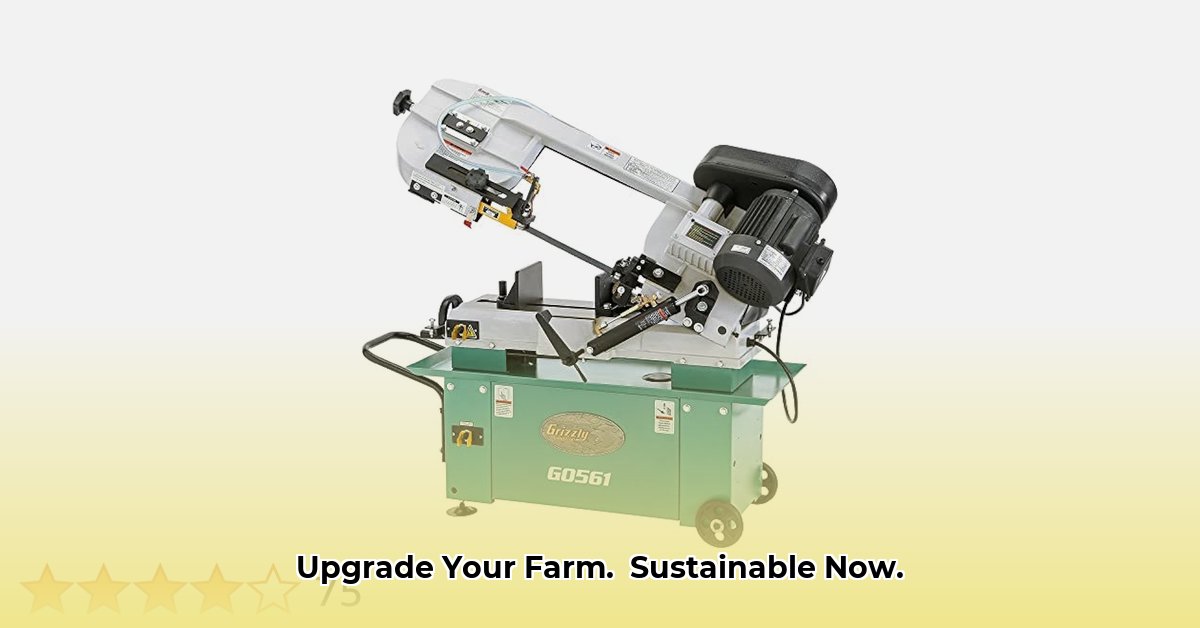
Choosing the Right Tractor Supply Bandsaw: Finding Your Perfect Fit
Sustainable farming demands efficiency. A Tractor Supply bandsaw can significantly boost your farm's productivity and sustainability efforts by enabling you to build, repair, and maintain essential equipment. But with various models available, selecting the right one is crucial. Don't worry; this guide will help you navigate the options.
First, assess your needs. Are you primarily focused on small repairs, constructing raised garden beds, or undertaking larger projects like building a small barn or compost bins? A smaller, more compact model might suffice for minor tasks, while larger, more powerful saws are necessary for heavier-duty work. For more information on sustainable farming practices, check out this helpful resource on neem oil.
Next, consider the types of wood you'll be cutting. Hardwoods require more powerful saws and durable blades than softwoods. Carefully review specifications like motor power (measured in horsepower), blade size (often expressed in inches), and cutting depth (the maximum thickness of wood you can cut). This information dictates the saw's capabilities.
Finally, leverage Tractor Supply's expertise. Their staff possesses valuable knowledge and can guide you toward the ideal bandsaw for your specific requirements.
Setting Up Your Band Saw: A Step-by-Step Guide
Before you start cutting, proper setup is paramount for both efficiency and safety. Here's a step-by-step guide to get you started:
Unpacking and Inspection: Carefully unpack your bandsaw, checking for any damage during shipping. Inspect all parts to ensure everything is present. A missing part can delay your work and even compromise safety.
Assembly: Following the manufacturer’s instructions, assemble the bandsaw. Take your time and ensure all components are properly aligned and secured. Rushing this step can easily lead to problems later.
Blade Installation: Correct blade installation is crucial. Refer to your owner's manual for detailed instructions on how to install the appropriate blade for your intended task. A poorly installed blade is a significant safety hazard.
Power Connection: Plug the bandsaw into a properly grounded power outlet. Ensure the outlet can handle the saw’s power requirements (listed on the specification plate).
Initial Test Run: Before you tackle your project, test the saw with scrap wood. This lets you check the blade's alignment and the saw's overall operation before working on valuable materials.
Essential Safety Precautions for Band Saw Operation
Safety should always be your top priority when operating power tools. Never compromise on safety; it's not worth the risk. Here are some key precautions:
Personal Protective Equipment (PPE): Always wear safety glasses to protect your eyes from flying debris. Ear protection is also crucial due to the saw's noise level. A dust mask prevents inhalation of sawdust.
Proper Work Holding: Secure your workpiece firmly using clamps or a vise. Never attempt to hold it by hand; this is incredibly dangerous.
Blade Guard: Ensure the blade guard is properly installed and functioning correctly. It helps prevent accidental contact with the blade.
Avoid Distractions: Concentrate on your work. Avoid distractions, and never operate the saw if you are tired or under the influence of drugs or alcohol.
Emergency Stop: Familiarize yourself with the location and operation of the emergency stop switch before starting any work.
Maintaining Your Band Saw for Optimal Performance
Regular maintenance ensures your bandsaw's longevity and performance. Neglecting maintenance can lead to premature wear, inefficiency, and potentially dangerous situations.
Post-Use Cleaning: After each use, carefully clean away sawdust and debris from the saw's body and blade area. This prevents buildup that might interfere with operation.
Blade Tension: Check and adjust blade tension periodically, as specified in your owner’s manual. Improper tension impacts cutting quality and safety.
Lubrication: Lubricate moving parts as recommended in the manual. Proper lubrication reduces friction and extends the saw's lifespan.
Blade Inspection: Regularly inspect the blade for damage, such as cracks or chips. Replace a damaged blade immediately; using a damaged blade is extremely unsafe.
Project Guide: Building a Raised Garden Bed with Your Band Saw
Building raised garden beds is a great way to improve soil control and yield. A bandsaw makes this project remarkably easy.
Measure and Cut: Use the bandsaw to accurately cut lumber according to your chosen dimensions for the bed's sides and base. Precise cuts are essential for structural integrity.
Assemble the Frame: Once cut, assemble the frame using screws or nails, ensuring square corners for stability.
Add a Base: Add a base to retain soil, using additional lumber or mesh. Your bandsaw can help cut mesh to size.
Fill and Plant: Once assembled, fill the bed with rich soil and plant your crops.
Project Guide: Constructing a Simple Compost Bin Frame
Composting is crucial for sustainable farming. A bandsaw simplifies this process:
Cut Lumber: Accurately cut lumber for the bin's frame using your bandsaw. Precise cuts ensure a well-fitting structure.
Assemble the Frame: Join the pieces securely, creating a sturdy, square frame.
Add Mesh (Optional): For better aeration, consider adding wire mesh to the sides. Your bandsaw can handle trimming the mesh.
Weighing the Pros and Cons: Is a Tractor Supply Bandsaw Right for You?
Before investing, consider the advantages and disadvantages.
Pros: Precise cuts for various projects; relatively inexpensive; versatile for numerous farm tasks; durable with proper care; relatively easy to learn.
Cons: Requires careful operation and maintenance; not ideal for massive-scale projects; needs dedicated workspace; produces sawdust, necessitating dust collection; may not be suitable for all wood types.
A Tractor Supply bandsaw offers a significant boost to sustainable farming practices. By carefully considering your needs and following this guide, you can significantly enhance your farm's productivity and efficiency. Remember, safety is paramount throughout the process.